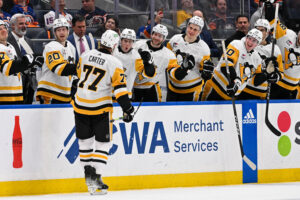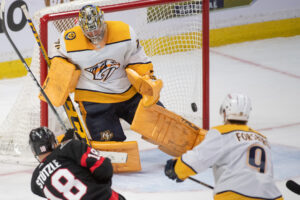As you have likely heard by now, the Arizona Coyotes pulled off a miracle yesterday. Rumoured for nearly a year now, they have pulled off the Oliver Ekman-Larsson trade with the Vancouver Canucks. William Grigsby who is Last Word on Hockey’s beat writer for the Coyotes has Arizona’s take here, but was it worth it from Vancouver’s perspective?
Ekman-Larsson Comes to Town
The Canucks and Coyotes have been working on this deal on-and-off since October. Vancouver pressed hard to the salary cap while Arizona had massive financial problems made them natural – if complicated – partners. Loads of pieces needed to be fit into shape, as can be seen by the end result.
https://twitter.com/FriedgeHNIC/status/1418678764855304194
Five players, three picks, AND salary retention? We may call this the Oliver Ekman-Larsson trade, but that’s a lot of moving parts to get together. It’s no wonder the teams, er, “ran out of time” on their previous attempts.
What’s to Hate About the Oliver Ekman-Larsson Trade
In talking to Canucks fans, it’s always easier to start here. Half the time they’ll beat you to it anyway, but it’s still worth mentioning. We’ll start with the obvious.
Salary Cap Hit
After waiting eagerly for the questionable deals Jim Benning has signed over the years to finally expire next season, here comes another six years! Even with salary being retained, the team has committed itself to $7.26 million into the future. Or at least until 2026-27, unless they can shed it sooner.
Given Ekman-Larsson’s diminishing skills and no-move clause, moving this deal is a remote possibility at best. And while the talk has been about Quinn Hughes and Elias Pettersson signing, if they go with short deals they’ll need to be signed again… and Ekman-Larsson’s deal will still be here.
As for Conor Garland, his cap hit remains unknown. The 25-year-old forward is, like earlier arrival Jason Dickinson, a restricted free agent. This is a wild card the Canucks don’t really need to be dealing with right now, but they don’t have much choice. After all, they traded for it.
The Defenceman
As has been pointed out repeatedly, Ekman-Larsson isn’t the defenceman he once was. He still has very good skating and good offence – three goals and 24 points in 46 games last season. And then… hm. The former Coyotes captain has had a rough ride of it over the past few years, with his contract becoming the focal point of fans’ ire.
While his possession numbers haven’t been as bad as his reputation, they aren’t what anyone wants at that pay grade. His Corsi has hovered around 48% for the past two seasons while facing modest competition. He’ll be 30 years old at the start of next season – his birthday was July 17th – and numbers rarely improve for athletes after then.
What’s to Love About the Oliver Ekman-Larsson Trade
Even the most one-sided-looking deals usually only look that way from one side. There’s plenty to like coming back to the Canucks in this.
The Forward
Conor Garland is hardly a kid, but he’s only got three years’ experience. Plus he got to the NHL honestly. He spent a full four years in the QMJHL and another two-plus in the AHL before making his big league debut. In the 164 NHL games, he’s scored 47 goals and 96 points in limited ice time.
In his third season, he was part of Arizona’s best line with Clayton Keller and Nick Schmaltz. While he won’t get that shot in Vancouver – Brock Boeser has the right side wrapped up – joining Bo Horvat and Nils Höglander should be fun to watch. In fact, with Dickinson and the expected arrival of Vasili Podkolzin Vancouver will have their best top-nine in years.
To Absent Friends
Nothing personal against the players leaving, but with this move the Canucks didn’t just drop $12 million in payroll. They also removed a player who wasn’t playing in Loui Eriksson, another who was heavily outmatched and showing his age in Jay Beagle, and an agitator who lost a step in Antoine Roussel.
That’s a fourth line that isn’t just far too expensive, but not terribly effective either. Those empty spaces allow for cheaper, younger players to step up. Or at least can give Tyler Motte a chance to play with linemates more his speed.
The Possibilities Are Some!
The Good News
Obviously the Canucks are hoping for a few things to happen here. First and most likely is that Garland becomes the top-six player they’ve been searching for on the cheap. Well, cheap hasn’t worked, so expensive it is! Still, if they can fill out their first three lines for around $6 million for him and Dickinson combined, that’s a win.
Even with Garland moving from the top line in Arizona to the second line in Vancouver, his scoring should remain high. The system Travis Green employs is fairly aggressive, and with Horvat freed from a match-up role his opportunities should increase.
That same system is what fans should be counting on for a rebirth of Ekman-Larsson as well. The defence is encouraged to go on the attack and to take risks in exchange for more offence. Lovely in theory, but the team has had basically one player who matches the style. It has been a rare thing that the Canucks have had a single 40-point defenceman, never mind two at once.
He should flourish in Vancouver – though almost certainly not enough to earn his full contract. Not for all six years, anyhow. Still, his relief at being out of the chaos that has been the perpetual soap opera in Arizona is palpable. With both alternate captains Brandon Sutter and Alexander Edler likely gone next season, Ekman-Larsson could well have a letter in 2021-22. But he won’t be the captain, and that has to be a weight off his shoulders as well.
The Bad News
This could easily go sideways, too. As mentioned, Ekman-Larsson is 30-years-old now, and even with salary retention that’s a LOT of cap hit for a LONG time. But there’s an out there, too. He’s owed a big signing bonus in 2022-23, but after that, it’s straight cash. If the team decides he is more expensive than he’s worth, they won’t have the Eriksson stumbling block.
No more signing bonuses means a simpler – and more cost-effective – buyout. If after two seasons a buyout makes sense they can do it while cutting the cap hit dramatically. That diminished hit would last until 2030-31, so ideally they’ll avoid it completely. Even the worst scenario is better than the financial corner they painted themselves into five years ago.
As for Garland, it’s going to depend partly on his salary ask and partly on how well he meshes with the Canucks. This shouldn’t be a problem, socially or stylistically, but you never know until it happens. As for his salary ask it’s a bit tough to know what will work, but the Canucks should be gunning for a longer deal if they can get it.
Ideally before arbitration, as that would limit the team to one or two years, and odds are very good he’ll be able to keep up his scoring pace for well beyond that. And more importantly, they don’t want deals now coming up at the same time as Pettersson’s or Hughes’.
Conclusion
Even though we’re calling this the Ekman-Larsson trade, there’s a lot here to digest. He’s obviously the biggest part of the deal, though, and the effect of bringing him to the team is going to reverberate for years. Was this a better deal a year ago? We can’t tell that.
What we can do is look at the changes presented here and try to guess what they will mean. And for Vancouver Canucks’ fans, that’s going to mean six years of watching the games with fingers crossed.
Main Photo:






